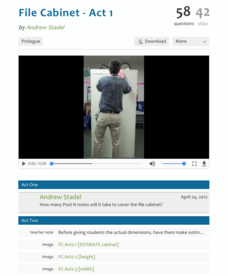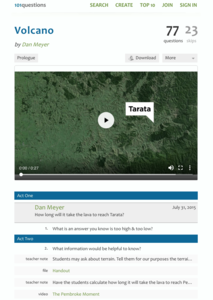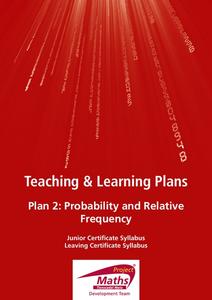Virginia Department of Education
How Many Triangles?
Something for young mathematicians to remember: the sum of any two sides must be greater than the third. Class members investigates the Triangle Inequality Theorem to find the relationship between the sides of a triangle. At the same...
EngageNY
Equivalent Ratios
Equivalent ratios show up on tape. Young mathematicians use tape diagrams to create equivalent ratios in the initial lesson on the topic. They learn the definition of equivalent ratios and use it to build others in the third segment of a...
Big Kid Science
Measuring Shadows Using an Ancient Method
How did ancient peoples determine the height of really tall objects? Young scientists and mathematicians explore the concept of using shadows to measure height in a hands-on experiment. Paired pupils measure shadows, then calculate the...
Education Development Center
Extending Patterns with Exponents
Don't think negatively about exponents. Young mathematicians dissect a fictional conversation between pupils trying to evaluate an expression with a negative exponent. This allows them to understand the meaning of negative exponents.
Shodor Education Foundation
Life
How does life evolve? The interactive provides a simulation based on the Game of Life invented by mathematician John Conway. Users can run the applet with the preset rules and settings or adjust them to view whether overpopulation or...
Shodor Education Foundation
Squaring the Triangle
Teach budding mathematicians how to square a triangle with an interactive that shows a graphical proof of the Pythagorean Theorem. Pupils alter the lengths of the legs using sliders. Using the inputted lengths, the applet displays the...
101 Questions
File Cabinet
Take the resource out of the file cabinet. Young mathematicians estimate the number of sticky notes it would take to cover the surface area of a file cabinet. They answer a set of questions on how the number of sticky notes would change...
101 Questions
Building Boxes
Build foundational knowledge of volume by building boxes. Given dimensions for a piece of grid paper, young mathematicians determine the number of possible open-top boxes it will make. As part of this task, they also find the box with...
101 Questions
Volcano
This resource will blow your mind! Young mathematicians estimate the rate of volcanic lava flow by watching a video. They apply the rate formula to determine how long it would take the lava to reach a city. Let's hope everyone gets out...
101 Questions
Taco Cart
Sometimes you just need a taco. Young mathematicians investigate two different paths on a beach to get to a taco cart. Completion of the task requires finding distances using the Pythagorean Theorem and considering the different walking...
101 Questions
Bubble Wrap
Let your lesson pop by using the resource. After watching a video of a man popping a square piece of bubble wrap, young mathematicians determine the time it would take to pop other pieces of bubble wrap with given dimensions. The...
Project Maths
Probability and Relative Frequency
It's all relatively simple once you get the gist. Young mathematicians learn about sample spaces and simple probability by conducting an activity with dice. To complete the second of six parts in the Statistics and Probability unit, they...
Mathematics Vision Project
Module 8: Probability
It's probably a good idea to use the unit. Young mathematicians learn about conditional probability using Venn diagrams, tree diagrams, and two-way tables. They also take into consideration independence and the addition rules.
Mathematics Vision Project
Module 3: Geometric Figures
It's just not enough to know that something is true. Part of a MVP Geometry unit teaches young mathematicians how to write flow proofs and two-column proofs for conjectures involving lines, angles, and triangles.
Mathematics Vision Project
Module 7: Modeling with Geometry
Model good modeling practices. Young mathematicians first learn about cross sections and solids of revolution. They then turn their attention to special right triangles and to the Laws of Sine and Cosine.
Mascil Project
Circular Pave-Stones Backyard
Pack the lesson into your plans. Young mathematicians learn about packing and optimization with the context of circular paving stones. They use coins to model the paving stones, and then apply knowledge of circles and polygons to...
PBS
KidVid: Fractions and Scale
Scale the challenge of learning about ratios and scales. Young mathematicians learn to incorporate fractional measurements when considering scales and scale factors. They use an interactive to investigate the concept and critically...
Purdue University
Rock Steady: Designing a Sensor
Bridge young mathematicians' knowledge of engineering and design. Pupils use two desks and a plastic sheet to simulate a bridge. After learning about energy transformations, they use available materials to design a sensor that detects...
Mathematics Assessment Project
Generating Polynomials from Patterns
Patterns and polynomials go hand in hand. Budding mathematicians analyze sequences of dot diagrams to discover the patterns in the number of white dots and black dots. They use the identified patterns to write and simplify a polynomial...
Radford University
What Is Normal?
Are you taller than a Major League Baseball player? Future mathematicians learn about normal distributions, percentiles, z-scores, and areas under a normal curve. They use the concepts to analyze height data of Major League Baseball...
Radford University
Business Ownership
Let's learn a little bit about business! Given information about a t-shirt company, young mathematicians explore the revenue, costs, profits, and future sales. They develop mathematical models for these quantities using linear,...
Radford University
Fibonacci is All Around
One ratio to rule them all. Young mathematicians investigate the Fibonacci sequence and the Golden Ratio. To begin the first lesson, they use a spreadsheet to see how the Fibonacci sequence gives the Golden Ratio. The second lesson...
Radford University
Parallel Lines Cut by a Transversal
Use the parallel lines to find your way. After first reviewing geometric constructions and the relationships between angles formed by parallel lines and a transversal, young mathematicians write proofs for theorems relating to parallel...
Radford University
Fun with Solids
Unlike a volcano, the lesson won't blow up in your face. Young mathematicians use dried beans to discover the relationship between the volumes of cones and cylinders and to write a formula for the volume of a cone. They then research...
Other popular searches
- Famous Mathematicians
- Great Mathematicians
- 5 Great Mathematicians
- Female Mathematicians
- Projects on Mathematicians
- Five Great Mathematicians
- The Great Mathematicians
- Mathematicians Fibonacci
- List of Great Mathematicians
- Hall of Great Mathematicians
- Whorls Famous Mathematicians
- The Old Grete Mathematicians

























